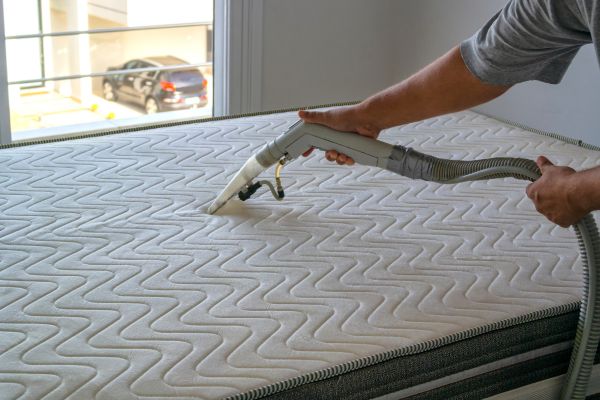Say goodbye to mold: Practical guide on how to remove mold from clothes and keep them fresh and clean
Clothes are like our daily allies, protecting us from the elements and expressing our personality. However, undesirable mold can become a villain and compromise not only the appearance of the pieces, but also our health. Mold can cause unpleasant stains, in addition to giving off unpleasant odors and, worst of all, triggering respiratory problems in sensitive people. In this guide, we will learn how remove mold from clothes and keep our wardrobe free from this persistent problem.
What is mold and why does it form on clothes?
Mold is a type of fungus that thrives in damp, poorly ventilated environments. These microscopic fungi find the perfect environment in clothing fibers to reproduce and grow. When our clothes become damp and remain damp for a long period of time, mold feeds on the fabrics, leaving behind those unsightly stains we all know. Similar to weeds spreading through an unprotected garden, mold can multiply quickly and ruin our favorite pieces.
For remove mold from clothes, we need to understand the relationship between the fungus and humidity. It's essential to address the causes of moisture, whether it's prolonged exposure to rain or improper storage. By combating moisture, we cut off mold's food source, stopping its proliferation and saving our clothes from a stained fate.
How to identify mold on clothes:
Early identification of mold is vital to prevent it from spreading further. Look for dark or greenish stains on clothing, especially in areas that are often damp or poorly ventilated. Resembling paint stains on a painting, these unwanted marks can spread if not treated in time. If you notice any signs of mold, it's time to act quickly and give your favorite clothes a new chance.
Noticing mold on clothes is not a difficult task, but it is important to be aware of the signs to ensure that the problem is resolved effectively. Regular wardrobe inspections can prevent unpleasant surprises and ensure you can wear your clothes with confidence.
Homemade methods to remove mold from clothes:
Now that we understand the nature of mold and how to identify it, let's explore some simple and effective solutions for eliminate mold from clothes. Fortunately, we can turn to common household ingredients like vinegar, baking soda, and lemon to safely and efficiently combat the problem. Just as a first aid kit can help heal wounds, this “emergency kit” for moldy clothes will become your best ally in the fight against mold.
What is mold and why does it form on clothes?
Mold is a common problem that can affect anyone and their clothes. Simply put, the mold is a type of fungus that grows in damp, poorly ventilated environments. Imagine mold as an unkempt garden, where our clothes are the vulnerable flowers. Just as an unkempt garden is ripe for weed growth, our clothes become a breeding ground for mold when exposed to high levels of humidity and lack of air circulation. Therefore, it is essential to understand how this problem forms to combat it effectively.
Damp clothes are like mold seeds, ready to germinate and proliferate in our wardrobes. When items are left damp after being exposed to rain or sweat, the moist environment becomes the starting point for fungus growth.
Moisture works like fertilizer, providing mold with what it needs to develop.
Likewise, the lack of ventilation in cabinets prevents fresh air from circulating, creating a stagnant environment perfect for the growth of these undesirable stains.
Preventing moisture build-up is key to preventing mold. Make sure to dry your clothes completely after washing and keep them in a well-ventilated place. Regular airing is like a gentle wind that keeps your laundry garden healthy. Additionally, it is important to pay attention to common causes of moisture, such as leaks in the home or natural humidity in regions with humid climates. By resolving these issues, you will prevent mold from flourishing in your closet again. Just as we tend our gardens so the flowers bloom, caring for our clothes will ensure they stay fresh and mold-free. So let's learn to remove mold from clothes and, at the same time, cultivate a healthy relationship between ourselves and our clothes.
How to identify mold on clothes:
When it's about identify mold on clothes, it is important to pay attention to the visual signs that indicate the presence of these unwanted fungi. Mold can manifest itself in different ways, but some common characteristics can help you recognize it easily. Dark or greenish spots are one of the most obvious signs that mold is taking hold on your clothes. These spots resemble drops of paint accidentally spilled on a board, gradually spreading and compromising the beauty of the piece.
Rapid identification of mold is essential to act promptly. Just as we clean stains from a painting to preserve its beauty, acting promptly against mold will ensure that your clothes remain pristine. Another warning sign is the characteristic and unpleasant odor that mold emits. This odor is like a dissonant symphony that we don't want our clothes to be a part of.
If you notice any signs of mold, it is important not to leave it for later. Remember that mold can spread quickly and become an even bigger problem if not treated properly. The comparison to a paint stain on a painting is not surprising: just as a paint stain can spread and damage the entire work of art, mold can also affect other nearby clothes in the wardrobe. Immediate action is like a brush that corrects the stain – eliminating mold before it spreads is essential to preserve your clothes and avoid irreparable damage.
Keeping an eye out for these signs and acting promptly is key to preventing mold from harming your clothes. After all, just as a stunning painting attracts everyone's eyes, your clean, well-groomed clothes reflect your attention to detail and your impeccable style. Let's now learn to remove mold from clothes efficiently and prevent it from ruining the perfect “picture” that is your wardrobe.
Homemade methods to remove mold from clothes:
When mold decides to take up residence in our clothes, it's time to take action and use the power of household ingredients to eliminate mold. Think of these methods as a “first aid kit” for your moldy clothes, offering a quick and effective solution to recover them. The vinegar, for example, is a true hero in this battle against mold. Its antibacterial and antifungal properties make it a powerful agent for remove mold from clothes. Simply dilute the vinegar in water and apply the solution to the affected areas, waiting a few minutes before rinsing. As a medicine that attacks infection, vinegar neutralizes mold and helps restore your clothes.
Another effective ally is sodium bicarbonate. This common ingredient in our kitchens acts as a “moisture absorber”, eliminating the favorable environment for mold to develop. Like a gauze that cleans the wound, simply sprinkle baking soda on the affected areas and let it sit for a few hours before gently brushing and washing your clothes as normal.
The lemon, known for its disinfectant and refreshing properties, can also be a great ally in the fight against mold. Lemon juice can be applied directly to mold stains or mixed with water for an effective cleaning solution. Similar to an invigorating medicine, lemon eliminates mold and leaves your clothes with a fresh, pleasant fragrance.
Just like we put together a first aid kit for emergencies, these household ingredients make a first aid kit for your moldy clothes. It's important to remember that although these at-home methods are effective, it's essential to test them on a small area of clothing before applying them more widely. Each tissue is unique and can react differently. By acting carefully and diligently, you will see that it is possible remove mold from clothes with simple and common ingredients, ensuring that they are always fresh and free from this villain. So, grab your home “first aid kit” and restore your favorite pieces to their former glory.
Removing Mildew from Different Types of Fabric:
Just as we take care of our skin according to its specific needs, we should also treat our clothes with the same care and attention. Each type of fabric reacts differently to mold treatment, so it is important explore the appropriate approach for each of them. The cotton, one of the most popular and versatile fabrics, is durable and can be treated with more vigorous methods to remove mildew from clothing. As a more robust skin, cotton can tolerate the use of stronger solutions, such as a mixture of vinegar and water.
On the other hand, the there It's like delicate, sensitive skin, requiring special care when dealing with mold. Gentler products, such as baking soda, are ideal for remove mold from woolen clothes, ensuring your soft parts remain intact. While lemon is great for some fabrics, wool may benefit more from the use of vinegar, as it works gently without damaging the delicate fibers.
A silk, like exquisite skin, requires especially delicate treatment to eliminate mold. The use of harsh chemicals can cause irreparable damage to delicate silk fibers. In this case, it is better to opt for a milder solution, such as lemon mixed with water, which will provide an effective but gentle treatment.
It is essential to remember that each fabric is like a unique skin, with its own characteristics. Just as sensitive skin needs specific care, our clothes also need appropriate treatments. Therefore, when remove mold from clothes, take into account the particularities of the fabric in question. Testing methods on a small area before applying them more widely is a good practice to ensure the safety and effectiveness of the treatment.
Like a dermatologist for your clothes, you now have the knowledge to care for different types of fabric properly, ensuring mold doesn't cause permanent damage. So, how about treating your clothes like the precious skin they are and giving them the personalized treatment they deserve? This way, you will always have an impeccable wardrobe, free from mold and ready to show off your best style.
Preventing mold on clothes:
Now that you've learned how to remove mold from clothes, it's time to focus on prevention so this problem doesn't return. The key to preventing mold from resurfacing is adopting simple but effective practices that will keep your clothes fresh and mold-free.
One of the top tips for preventing mold from returning is to ensure that the environment in which your clothes are stored is dry and well ventilated. Similar to how damp skin is more prone to problems, clothes in humid environments are more susceptible to mold growth. Make sure the closet or place where you store your clothes is free from excessive moisture. Use silica gel sachets or dehumidifiers to help keep the room dry and absorb any unwanted moisture. Additionally, leaving cabinet doors open occasionally will allow fresh air to circulate, preventing mold from finding a suitable environment to grow.
Another valuable suggestion is the proper storage of clothes. Just as we take care of our skin by protecting it from external aggressions, our clothes also need care when they are stored. Make sure your clothes are completely dry before putting them away. Avoid accumulating items in a small space, as this can restrict ventilation and encourage the formation of mold. Hanging your clothes on hangers or folding them carefully, ensuring they are spaced out, is a practice that helps prevent mold.
Remember that prevention is the best medicine. Similar to how we take care of our health to avoid illness, taking care of the environment in which our clothes are stored is the most effective way to prevent mold from returning. Keep humidity under control, let air circulate, and store your clothes carefully, and they will remain spotless and mold-free. With these practices in mind, you'll be protecting your wardrobe like precious skin, ensuring your clothes remain stunning and ready to wear for any occasion.
With a combination of prevention and cleaning methods, you will be able to keep your wardrobe like a work of art, free from unwanted stains. After all, there's no better feeling than wearing an outfit that makes us feel confident and well-groomed. So, how about starting to implement these tips right now and ensure that your clothes remain impeccable and stunning in every season?
Other helpful clothing care tips:
In addition to knowing how remove mold from clothes and prevent its return, it is important to understand the direct relationship between cleaning clothes and their conservation. Just as we take care of our skin to keep it young and healthy, properly cleaning our clothes is essential to prolonging their useful life. Clean clothes not only make us feel good, but they also ensure that they remain free of unwanted odors and stains that can become permanent. Regular cleaning is like an elixir that rejuvenates our clothes, keeping them in impeccable condition for long-term use.
To properly wash your clothes, it is essential to read and follow the instructions on the care labels present on each item. Labels are like the map to proper care, indicating washing temperature, drying method and other important information. Use detergents suitable for each type of fabric and avoid using aggressive bleaches that could cause damage. Washing clothes similar to washing your face – with kindness and attention to detail – preserves the integrity of the fibers and the color of the garments.
Correct drying is as important as washing. Avoid exposing your clothes to direct sunlight for long periods, as sunlight can fade colors and weaken fibers. Choose to dry in the shade in a well-ventilated place, also avoiding the use of dryers at high temperatures. Just like we take care of our skin by avoiding excessive exposure to the sun, our clothes also need protection from sun damage.
When storing your clothes, look for fold them properly or hang them on hangers to prevent them from getting crushed or deformed. Well-organized clothes are like a reflection of well-cared for skin, providing you with the convenience of easily finding what you need and ensuring that your pieces are always ready to wear.
Remember that Taking care of your clothes is a form of self-care. Just as a skincare routine keeps our skin radiant and healthy, adopting appropriate care practices for our clothes allows us to enjoy flawless, long-lasting pieces. So, implement these tips into your routine and see how your clothes will reciprocate with an impeccable and confident look on every occasion. Take good care of your clothes, and they will take good care of you!
Conclusion:
Throughout this blog post, we explore in detail and objectively how remove mold from clothes and, most importantly, how to prevent its return. Remembering that mold is like an unwanted visitor that can compromise the beauty and integrity of our favorite pieces. However, with the knowledge gained, you are ready to face this challenge head on and ensure that your clothes always remain impeccable and free from this persistent problem.
Recapping the main points covered, we highlight the importance of acting quickly to identify mold on clothes and prevent it from spreading. Just like an ink stain on a painting, mold needs to be treated promptly to prevent further damage. Additionally, we learned how remove mold from clothes using homemade methods such as using vinegar, baking soda and lemon. These household ingredients are like a “first aid kit” for our moldy clothes, ensuring an effective and affordable solution.
We also learned that each type of fabric requires specific care when it comes to eliminating mold. Just as our unique skin needs proper treatments, our clothes also need personalized attention. By following best practices for washing, drying and storing, you'll be protecting your clothes like valuable leather, ensuring they remain in pristine condition.
So now it's time to put all the tips shared here into practice. Remember that the Prevention is key to preventing mold from returning, so keep the environment dry and well ventilated, and take good care of your clothes during washing and storage. And if you have your own experiences and suggestions to share, feel free to leave your comments below. Knowledge sharing is like watering a collective garden, and together we can further enrich our understanding of how to care for our clothes.
With these valuable tips in mind, you'll be ready to keep your wardrobe a gallery of impeccable and elegant pieces. Just as taking care of our skin reflects on our well-being, taking care of our clothes is a form of self-care and self-expression. So, put these practices into action and enjoy a mold-free wardrobe filled with style and confidence for every occasion!






